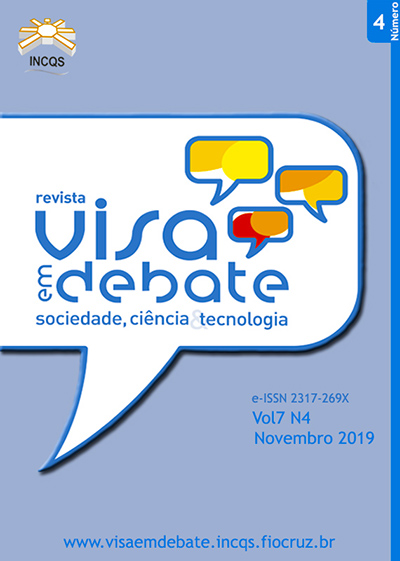Descriptive analysis of notifications of adverse events of cosmetic products registered in Notivisa, from 2006 to 2018
DOI:
https://doi.org/10.22239/2317-269X.01384Keywords:
Brazilian Health Surveillance Agency, Brazil, Cosmetics, Adverse Effect, Health Surveillance, CosmetovigilanceAbstract
Introduction: The National Health Surveillance Agency (Anvisa) defines cosmetovigilance as the set of measures that allows assessing the risk of occurrence of undesirable events attributed to the use of cosmetic products, including the capture of adverse events (AE). From 2006 Anvisa began to receive EA notifications involving cosmetic products, with the implementation of the Sanitary Surveillance Notification System (Notivisa). Objective: This study analyzed the notifications of adverse effects related to the use of cosmetic products, registered in Notivisa, from 2006 to 2018. Method: This is a quantitative, descriptive and retrospective study whose database was extracted from the Notivisa system, nationwide, from November 2006 to December 2018. Results: We identified 367 adverse effects involving cosmetic products with an average of 31 notifications per year. Reports of adverse effects came mainly from the Southeast (48.1%; 176) and South (25.1%; 92) regions of the country with a predominance of females (66.2%; 243). It was observed that the citizen is the on ewho most reports adverse effects (58.0%; 213) related to cosmetic products, with more complaints about infant and geriatric diapers (15.0%; 26), facial / body creams (14.1%; 24), hair straighteners (17.8%; 35) and sunscreens (14.8%; 29). The most common adverse effects were irritation (46.0%; 17), allergy (30.5%; 11) and burning (30.5%; 11). The reported effects are mostly performed by female citizens from the richest regions of the country, attributed to products of daily use and characterized by the presence of irritation, allergy and burning. Conclusions: These results have demonstrated the need to improve Anvisa’s Cosmetovigilance System, defining strategies for adherence to adverse effect reports, as well as the adoption of a causal assessment method appropriate to the specificities of cosmetic products.
Downloads
Downloads
Published
Issue
Section
License
Copyright (c) 2019 Health Surveillance under Debate: Society, Science & Technology (Vigilância Sanitária em Debate: Sociedade, Ciência & Tecnología) – “Visa em Debate”

This work is licensed under a Creative Commons Attribution-NonCommercial-NoDerivatives 4.0 International License.
COPYRIGHT ALLOWANCE The author (s) hereinafter designated as the ASSIGNOR hereby assign and transfer, free of charge, the ownership of the copyrights related to this ARTICLE to the Vigilância Sanitária em Debate: Sociedade, Ciência & Tecnologia (Health Surveillance under Debate: Society, Science & Technology) – Visa em Debate, represented by FUNDAÇÃO OSWALDO CRUZ, established at Av. Brasil, nº 4365, Manguinhos, Rio de Janeiro, RJ, Brazil, CEP 21045-900, under the conditions set out below: (a) The terms and conditions set forth in this Agreement shall apply to the following: 1. The ASSIGNOR declares that they s(he) is (are) the author (s) and owner (s) of the copyrighted property of the ARTICLE submitted. 2. The ASSIGNOR declares that the ARTICLE does not infringe the copyrights and / or other property rights of third parties, that the disclosure of images (if any) has been authorized and that they s(he) assume(s) full moral and / or property liability for its content, before third parties. 3. THE ASSIGNOR assigns and transfers all copyrights relating to the ARTICLE to the ASSIGNEE, especially the rights of editing, publication, translation into another language and reproduction by any process or technique. The ASSIGNEE becomes the exclusive owner of the rights related to the ARTICLE, and any reproduction, totally or partially, is prohibited in any other means of publicity, printed or electronic, without prior written authorization from the ASSIGNEE. 4. The assignment is free and, therefore, there will be no remuneration for the use of the ARTICLE by the ASSIGNEE.







